Not All Correct Answers Are Equal: Why Your Distillation Source Matters
并非所有正确答案都同等重要:为何你的蒸馏来源至关重要
Abstract
摘要
Distillation has emerged as a practical and effective approach to enhance the reasoning capabilities of open-source language models. In this work, we conduct a largescale empirical study on reasoning data distillation by collecting verified outputs from three state-of-the-art teacher models—AM-Thinking-v1, Qwen3-235B-A22B, and DeepSeek-R1—on a shared corpus of 1.89 million queries. We construct three parallel datasets and analyze their distributions, revealing that AM-Thinking-v1- distilled data exhibits greater token length diversity and lower perplexity. Student models trained on each dataset are evaluated on reasoning benchmarks including AIME2024, AIME2025, MATH500, and Live Code Bench. The AM-based model consistently achieves the best performance (e.g., 84.3 on AIME2024, 72.2 on AIME2025, 98.4 on MATH500, and 65.9 on Live Code Bench) and demonstrates adaptive output behavior—producing longer responses for harder tasks and shorter ones for simpler tasks. These findings highlight the value of high-quality, verified reasoning traces. We release the AM-Thinking-v1 and Qwen3-235B-A22B distilled datasets to support future research on open and high-performing reasoning-oriented language models. The datasets are publicly available on Hugging Face2.
蒸馏已成为增强开源语言模型推理能力的实用且有效方法。本研究通过从三个前沿教师模型(AM-Thinking-v1、Qwen3-235B-A22B和DeepSeek-R1)在189万条共享查询语料上收集已验证输出,开展了大规模推理数据蒸馏实证研究。我们构建了三个平行数据集并分析其分布特征,发现AM-Thinking-v1蒸馏数据具有更显著的token长度多样性和更低困惑度。在各数据集上训练的学生模型在AIME2024、AIME2025、MATH500和Live Code Bench等推理基准测试中接受评估。基于AM的模型始终表现最佳(如AIME2024达84.3分、AIME2025达72.2分、MATH500达98.4分、Live Code Bench达65.9分),并展现出适应性输出行为——对困难任务生成更长响应,对简单任务生成更短响应。这些发现凸显了高质量已验证推理轨迹的价值。我们开源AM-Thinking-v1和Qwen3-235B-A22B蒸馏数据集以支持未来开放高性能推理导向语言模型研究,数据集已在Hugging Face平台公开。
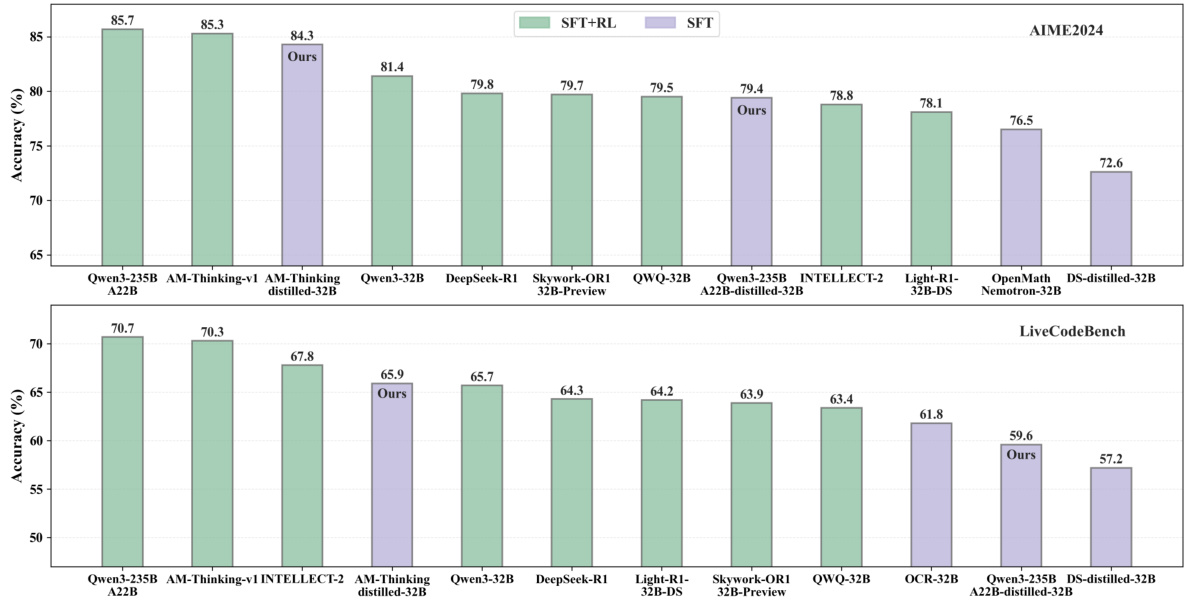
Figure 1: Open-source model benchmarks on AIME2024/Live Code Bench.

图 1: AIME2024/Live Code Bench 上的开源模型基准测试。
1 Introduction
1 引言
Recent work has demonstrated the effectiveness and efficiency of distillation-based training for enhancing the reasoning ability of Large Language Models (LLMs) [1, 2, 3]. By transferring reasoning traces from stronger teacher models, distilled data enables smaller or open-source models to achieve significant improvements on challenging tasks such as mathematics, coding, and scientific reasoning.
近期研究表明,基于蒸馏的训练方法能有效提升大语言模型(LLMs)的推理能力[1,2,3]。通过从更强的教师模型中迁移推理轨迹,经蒸馏处理的数据可使较小规模或开源模型在数学、编程和科学推理等复杂任务上取得显著进步。
Building on this line of research, we systematically distilled reasoning data from three state-ofthe-art models: DeepSeek-R1 [1], Qwen3-235B-A22B [3], and AM-Thinking-v1 [4]. For each of approximately 1.89 million identical queries, we collected full chain-of-thought responses from all three models, resulting in three parallel large-scale datasets. This unique setup allows for a direct comparison of reasoning styles and data distributions across leading models.
基于这一研究方向,我们系统性地从三个前沿模型中提取了推理数据:DeepSeek-R1 [1]、Qwen3-235B-A22B [3] 和 AM-Thinking-v1 [4]。针对约189万条相同查询,我们收集了这三个模型的完整思维链响应,最终形成三个并行的大规模数据集。这一独特设置实现了对领先模型间推理风格与数据分布的直接对比。
We carefully processed and cleaned all three datasets, including thorough de duplication, strict filtering, and contamination removal. We further analyzed the data distributions and content diversity to provide a comprehensive understanding of the strengths and characteristics of each distillation source.
我们仔细处理和清理了所有三个数据集,包括彻底的去重、严格过滤和污染去除。进一步分析了数据分布和内容多样性,以全面了解每个蒸馏来源的优势和特点。
Our experiments show that models trained with data distilled from AM-Thinking-v1 achieve particularly strong performance. On challenging reasoning benchmarks, such as AIME2024 [5] (84.3), AIME2025 [6] (72.2), MATH500 [7] (98.4), and LiveCodeBench [8] (65.9), the AM-Thinking-v1 distilled model consistently outperforms those trained on Qwen3-235B-A22B or DeepSeek-R1 data. Moreover, our analysis reveals that the AM-Thinking-v1 distilled model exhibits an adaptive generation length: producing longer responses on harder tasks (e.g., AIME, Live Code Bench), and shorter ones on simpler datasets (e.g., MATH500). This behavior aligns with the token-level distribution of the AM-distilled dataset, which contains both short and long responses more frequently than the other two sources.
我们的实验表明,使用AM-Thinking-v1蒸馏数据训练的模型展现出特别强劲的性能。在AIME2024 [5] (84.3)、AIME2025 [6] (72.2)、MATH500 [7] (98.4) 和 LiveCodeBench [8] (65.9) 等具有挑战性的推理基准测试中,AM-Thinking-v1蒸馏模型的表现始终优于基于Qwen3-235B-A22B或DeepSeek-R1数据训练的模型。此外,分析显示该模型具有自适应生成长度的特性:在较难任务(如AIME、Live Code Bench)上生成更长响应,在较简单数据集(如MATH500)上生成更短响应。这一特性与AM蒸馏数据集的token级分布相吻合——相比其他两种数据源,该数据集同时包含更多高频出现的短响应和长响应。
These results highlight the practical value of large-scale, high-quality reasoning data distillation, for improving open-source LLMs. To promote further progress in the field, we release both the AM-Thinking-v1 and Qwen3-235B-A22B distilled datasets3. We hope our work provides valuable resources and insights for the open-source community, enabling more effective reasoning-focused model development and contributing to the broader progress of reasoning research.
这些结果突显了大规模高质量推理数据蒸馏对于提升开源大语言模型的实用价值。为推动该领域进一步发展,我们同时发布了AM-Thinking-v1和Qwen3-235B-A22B蒸馏数据集[3]。希望我们的工作能为开源社区提供宝贵资源与洞见,助力开发更高效的推理导向模型,并推动推理研究领域的整体进步。
2 Data
2 数据
This section first introduces the data preprocessing and distillation pipeline used to construct our training corpus, and then presents a detailed analysis of the resulting datasets in terms of distribution, length, and quality.
本节首先介绍用于构建训练语料库的数据预处理和蒸馏流程,随后从分布、长度和质量三个维度对最终数据集进行详细分析。
2.1 Data Collection and Query Processing
2.1 数据收集与查询处理
To support robust and comprehensive model training, we constructed a large-scale training corpus by aggregating data from a diverse set of publicly available open-source corpora. These corpora span a broad range of NLP tasks, including mathematical reasoning, code generation, scientific reasoning, instruction following, multi-turn dialogue, and general reasoning. For downstream analysis and targeted data processing, each data source was systematically assigned to a specific task category.
为支持稳健且全面的模型训练,我们通过整合多种公开开源语料库构建了大规模训练数据集。这些语料涵盖数学推理、代码生成、科学推理、指令跟随、多轮对话和通用推理等广泛NLP任务。为便于下游分析和定向数据处理,每个数据源均被系统归类至特定任务范畴。
Training Data Categories The aggregated training data were classified as follows:
训练数据类别
汇总后的训练数据分类如下:
Query Preprocessing To guarantee the reliability of subsequent model training, we applied rigorous multi-stage preprocessing to the raw queries:
查询预处理
为确保后续模型训练的可靠性,我们对原始查询进行了严格的多阶段预处理:
- De duplication: Exact duplicate queries (identical text) were removed.
- 去重:完全重复的查询(文本相同)被移除。
2. Filtering:
- 过滤:
- Decontamination: To mitigate data contamination, especially regarding the core evaluation set (e.g., AIME2024 [5]), we conducted both exact match filtering and semantic deduplication. The latter leveraged the bge-m3 embedding model [26] to compute semantic similarity, removing queries exceeding a threshold of 0.9 with respect to the evaluation set.
- 去污染处理:为减轻数据污染问题,特别是针对核心评估集(如 AIME2024 [5]),我们同时进行了精确匹配过滤和语义去重。后者采用 bge-m3 嵌入模型[26]计算语义相似度,移除与评估集相似度超过0.9阈值的查询项。
2.2 Data Distilling
2.2 数据蒸馏
After preprocessing, we performed large-scale data distillation to further enhance the quality of our training corpus.
预处理后,我们进行了大规模数据蒸馏以进一步提升训练语料的质量。
Distillation Framework For each pre processed query, we adopted an incremental distillation strategy using three state-of-the-art models: AM-Thinking-v1 [4], Qwen3-235B-A22B [3], and DeepSeek-R1 [1]. Each query was independently distilled by these three models. For every model, the distillation process was repeated on the same query until the generated response satisfied the verification criterion (i.e., the verification score $\geq0.9$ ). Consequently, each query yielded up to three high-quality distilled outputs, corresponding to the three models, with each output refined iterative ly until it passed the automatic verification.
蒸馏框架
针对每个预处理后的查询,我们采用了一种增量式蒸馏策略,利用三个前沿模型:AM-Thinking-v1 [4]、Qwen3-235B-A22B [3] 和 DeepSeek-R1 [1]。每个查询均由这三个模型独立进行蒸馏处理。对于每个模型,同一查询的蒸馏过程会重复进行,直到生成的响应满足验证标准(即验证分数 $\geq0.9$)。因此,每个查询最多可产生三个高质量的蒸馏输出,分别对应三个模型,且每个输出均经过迭代优化直至通过自动验证。
Automatic Verification and Scoring To ensure the reliability and correctness of the distilled data, we employed automatic verification procedures tailored for each data category, assigning a verification score (verify score) to every model-generated response:
自动验证与评分
为确保蒸馏数据的可靠性和正确性,我们针对每类数据定制了自动验证流程,为每个模型生成的回答分配验证分数 (verify score):
• Multi-turn Conversations and General Reasoning: Decision-Tree-Reward-Llama-3.1- 8B [29] was used to evaluate coherence, correctness, and helpfulness, which were aggregated into a normalized composite score.
- 多轮对话与通用推理:使用 Decision-Tree-Reward-Llama-3.1-8B [29] 评估连贯性、正确性和实用性,并汇总为标准化综合得分。
A unified verification score threshold of 0.9 was used across all data categories.
所有数据类别均采用统一的验证分数阈值0.9。
Quality Assurance Measures To further enhance data quality, we introduced several additional validation and filtering strategies:
质量保障措施
为进一步提升数据质量,我们引入了多项额外的验证与过滤策略:
Ultimately, this process yielded a comprehensive dataset of 1.89 million queries, each paired with high-quality, verified responses distilled from all three models.
最终,这一过程生成了一个包含189万条查询的全面数据集,每条查询都与从三个模型中提炼出的高质量、已验证回答配对。
2.3 Data Analysis
2.3 数据分析
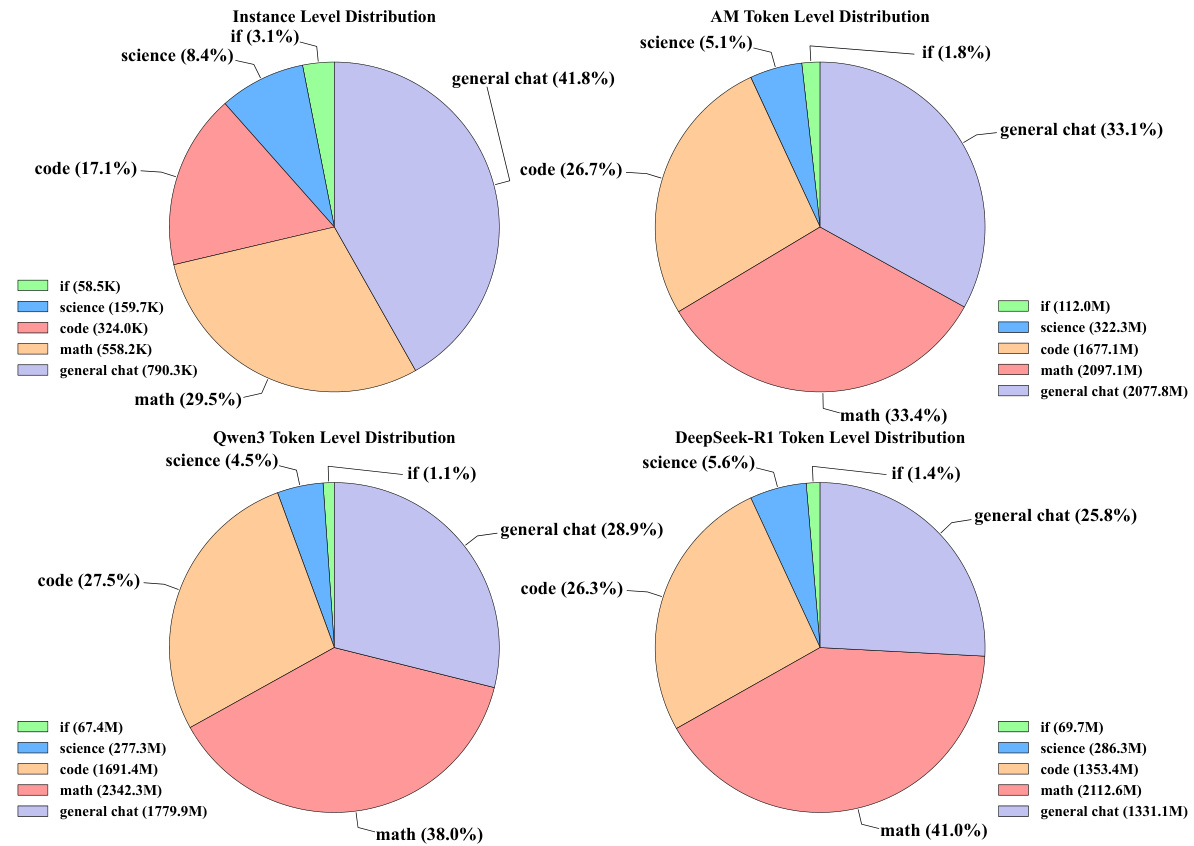
Figure 2: Instance-level and token-level output distributions are analyzed for AM-Thinkin-v1, Qwen3- 235B-A22B, and DeepSeek-R1. The general chat includes both multi-turn conversations and other types of data.
图 2: 针对 AM-Thinkin-v1、Qwen3-235B-A22B 和 DeepSeek-R1 的实例级和 token 级输出分布进行分析。通用聊天数据包含多轮对话及其他类型数据。
We conduct a detailed analysis of the training data distilled from three different large-scale models: AM-Thinking-v1 [4], Qwen3-235B-A22B [3], and DeepSeek-R1 [1]. This comparative analysis covers the instance-level and token-level output distributions, token length characteristics, and perplexity (PPL) distributions, providing insight into the data quality and structural tendencies of each dataset.
我们对三种不同大规模模型的训练数据进行了详细分析:AM-Thinking-v1 [4]、Qwen3-235B-A22B [3] 和 DeepSeek-R1 [1]。这项对比分析涵盖了实例级和 Token 级的输出分布、Token 长度特征以及困惑度 (PPL) 分布,揭示了各数据集的数据质量与结构倾向性。
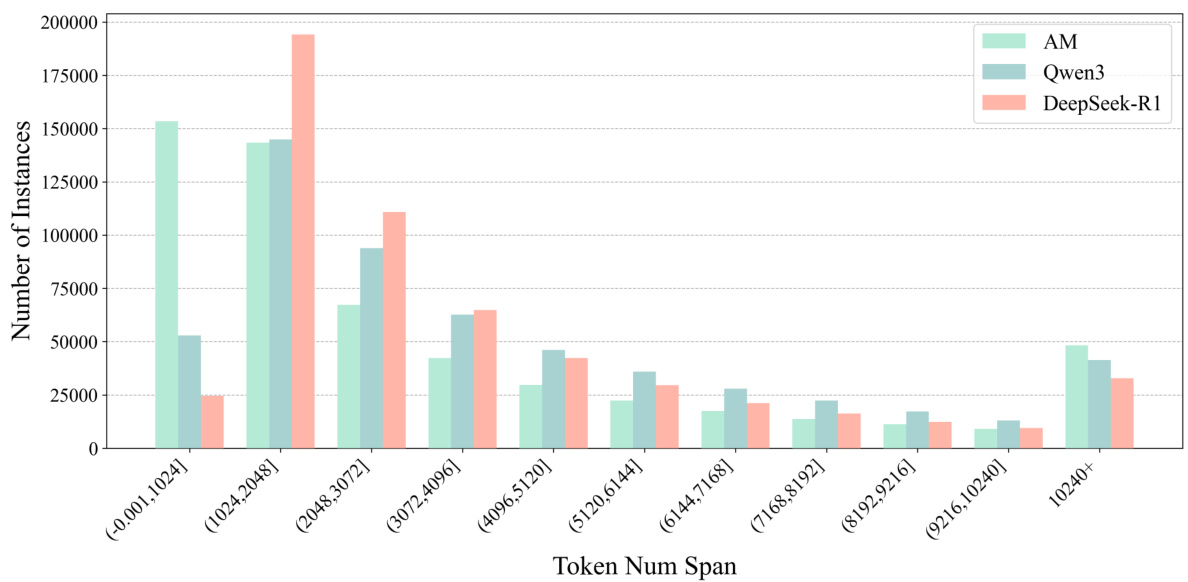
Figure 3: Token span distribution of instances for AM-Thinking-v1, Qwen3-235B-A22B, and DeepSeek-R1 on math.
图 3: AM-Thinking-v1、Qwen3-235B-A22B 和 DeepSeek-R1 在数学题上的 Token 跨度分布实例。
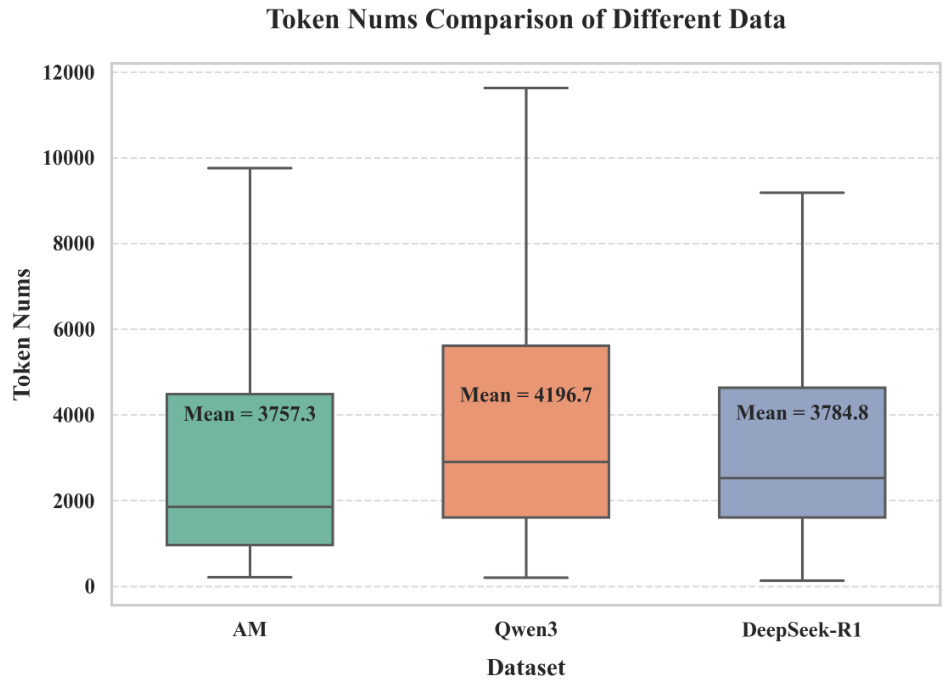
Figure 4: Token count distributions for AM-Thinking-v1, Qwen3-235B-A22B, and DeepSeek-R1 datasets. Box plots show the distribution of token numbers, with means labeled. Qwen3-235B-A22B has the highest average token count, followed by DeepSeek-R1 and AM-Thinking-v1.
图 4: AM-Thinking-v1、Qwen3-235B-A22B 和 DeepSeek-R1 数据集的 Token 数量分布。箱线图展示了 Token 数量的分布情况,并标注了平均值。Qwen3-235B-A22B 的平均 Token 数量最高,其次是 DeepSeek-R1 和 AM-Thinking-v1。
Figure 2 shows the output distribution of these datasets at both the instance and token levels. The instance-level distribution (top-left) reveals that this dataset includes a high proportion of general chat $(41.8%)$ , followed by math $(29.5%)$ and code $(17.1%)$ . In contrast, Qwen3-235B-A22B and DeepSeek-R1 token-level distributions (bottom charts) show a more pronounced focus on math $38.0%$ and $41.0%$ respectively), with general chat and code sharing similar proportions. Notably, AM-Thinking-v1’s token-level distribution (top-right) also emphasizes math $(33.4%)$ , albeit to a lesser extent than DeepSeek-R1. Science and instruction-following (IF) data make up a minor share across all datasets.
图 2 展示了这些数据集在实例级别和token级别的输出分布。实例级分布(左上)显示该数据集包含较高比例的通用聊天$(41.8%)$,其次是数学$(29.5%)$和代码$(17.1%)$。相比之下,Qwen3-235B-A22B和DeepSeek-R1的token级分布(底部图表)显示出更明显的数学侧重($38.0%$和$41.0%$),通用聊天和代码占比相近。值得注意的是,AM-Thinking-v1的token级分布(右上)也强调数学$(33.4%)$,尽管程度低于DeepSeek-R1。科学和指令遵循(IF)数据在所有数据集中占比较小。
Further, Figure 3 presents the token span distribution specifically for math instances. It demonstrates that AM-Thinking-v1’s math data exhibits a highly dispersed distribution—many short sequences (under 1024 tokens) and a substantial portion of very long sequences ( $10240+$ tokens). This reflects the token distribution characteristics under a fixed query set, where AM-Thinking-v1 tends to produce both short and very long responses more frequently. In contrast, Qwen3-235B-A22B’s data generally exhibits longer token spans, indicating a tendency toward producing longer responses. DeepSeekR1’s token spans are mostly concentrated between 1k and $8\mathrm{k\Omega}$ tokens, showing a moderate range of response lengths.
此外,图 3 展示了专门针对数学实例的 token 跨度分布。结果表明,AM-Thinking-v1 的数学数据呈现出高度分散的分布特征——存在大量短序列(低于 1024 token)和相当比例的超长序列(超过 $10240+$ token)。这反映了固定查询集下的 token 分布特性,即 AM-Thinking-v1 更频繁地生成较短或极长的响应。相比之下,Qwen3-235B-A22B 的数据通常表现出更长的 token 跨度,表明其倾向于生成更长的响应。DeepSeekR1 的 token 跨度主要集中在 1k 至 $8\mathrm{k\Omega}$ token 之间,显示出中等范围的响应长度。
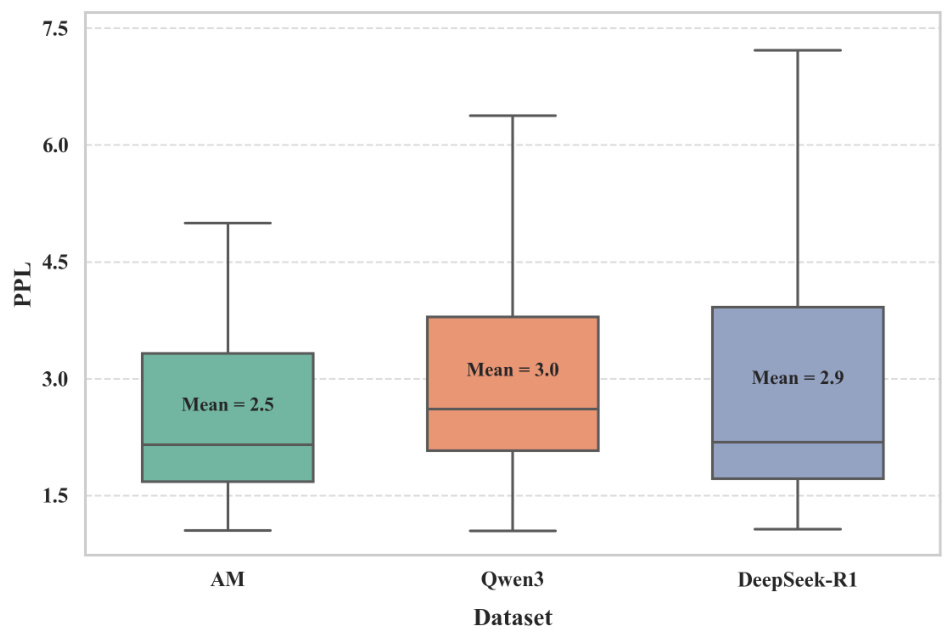
Figure 5: Perplexity (PPL) distributions for AM-Thinking-v1, Qwen3-235B-A22B, and DeepSeek-R1 datasets. Box plots show PPL distributions, with means labeled. AM-Thinking-v1 achieves the lowest mean PPL, indicating better overall quality.
图 5: AM-Thinking-v1、Qwen3-235B-A22B 和 DeepSeek-R1 数据集的困惑度 (PPL) 分布。箱线图展示了 PPL 分布情况,并标注了平均值。AM-Thinking-v1 实现了最低的平均 PPL,表明其整体质量更优。
Box plots in Figure 4 provide further insight into the average token length per instance. The Qwen3- 235B-A22B dataset has the highest mean token count (4196.7), followed by DeepSeek-R1 (3784.8) and AM-Thinking-v1 (3757.3). This aligns with the histogram observation that Qwen3-235B-A22B emphasizes longer instances, whereas AM-Thinking-v1 covers a broader range of lengths, including extremely short and long sequences.
图4中的箱线图进一步展示了每个实例的平均token长度。Qwen3-235B-A22B数据集的平均token数最高(4196.7),其次是DeepSeek-R1(3784.8)和AM-Thinking-v1(3757.3)。这与直方图观察结果一致:Qwen3-235B-A22B侧重较长实例,而AM-Thinking-v1覆盖的范围更广,包含极短和极长序列。
Finally, Figure 5 compares the perplexity (PPL) across the datasets. Perplexity is a key measure of language model performance, with lower values indicating better quality. Among the three datasets, AM-Thinking-v1 achieves the lowest mean PPL (2.5), suggesting that its distilled outputs are generally of higher quality. DeepSeek-R1 (mean $\mathrm{PPL}=2.9\$ ) performs slightly better than Qwen3 (mean $\mathrm{PPL}=3.0\AA$ ), highlighting the relatively strong performance of AM-distilled data in terms of perplexity.
最后,图 5 比较了各数
